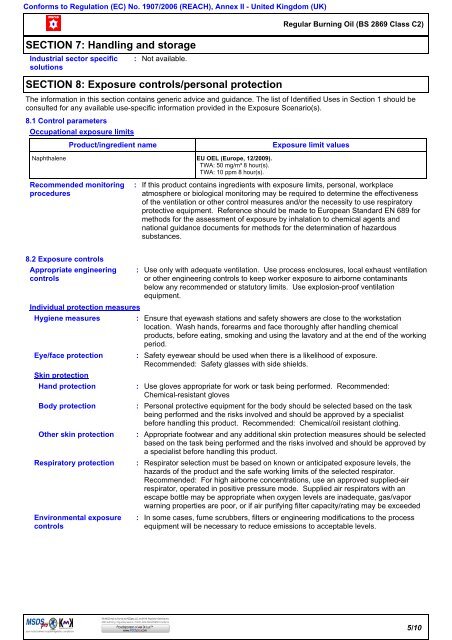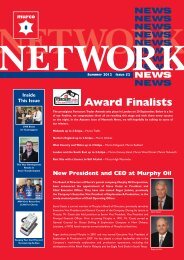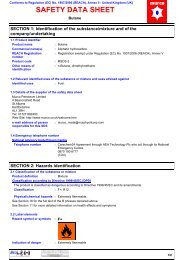Low Sulphur Regular Burning Oil â BS 2869 ... - Murco Petroleum
Low Sulphur Regular Burning Oil â BS 2869 ... - Murco Petroleum
Low Sulphur Regular Burning Oil â BS 2869 ... - Murco Petroleum
Create successful ePaper yourself
Turn your PDF publications into a flip-book with our unique Google optimized e-Paper software.
Conforms to Regulation (EC) No. 1907/2006 (REACH), Annex II - United Kingdom (UK)<br />
SECTION 7: Handling and storage<br />
<strong>Regular</strong> <strong>Burning</strong> <strong>Oil</strong> (<strong>BS</strong> <strong>2869</strong> Class C2)<br />
Industrial sector specific<br />
solutions<br />
:<br />
Not available.<br />
SECTION 8: Exposure controls/personal protection<br />
The information in this section contains generic advice and guidance. The list of Identified Uses in Section 1 should be<br />
consulted for any available use-specific information provided in the Exposure Scenario(s).<br />
8.1 Control parameters<br />
Occupational exposure limits<br />
Product/ingredient name<br />
Exposure limit values<br />
Naphthalene EU OEL (Europe, 12/2009).<br />
TWA: 50 mg/m³ 8 hour(s).<br />
TWA: 10 ppm 8 hour(s).<br />
Recommended monitoring<br />
procedures<br />
:<br />
If this product contains ingredients with exposure limits, personal, workplace<br />
atmosphere or biological monitoring may be required to determine the effectiveness<br />
of the ventilation or other control measures and/or the necessity to use respiratory<br />
protective equipment. Reference should be made to European Standard EN 689 for<br />
methods for the assessment of exposure by inhalation to chemical agents and<br />
national guidance documents for methods for the determination of hazardous<br />
substances.<br />
8.2 Exposure controls<br />
Appropriate engineering<br />
controls<br />
Individual protection measures<br />
Hygiene measures :<br />
Eye/face protection<br />
Skin protection<br />
Hand protection<br />
Body protection :<br />
Other skin protection<br />
Respiratory protection :<br />
Environmental exposure<br />
controls<br />
:<br />
:<br />
:<br />
:<br />
:<br />
Use only with adequate ventilation. Use process enclosures, local exhaust ventilation<br />
or other engineering controls to keep worker exposure to airborne contaminants<br />
below any recommended or statutory limits. Use explosion-proof ventilation<br />
equipment.<br />
Ensure that eyewash stations and safety showers are close to the workstation<br />
location. Wash hands, forearms and face thoroughly after handling chemical<br />
products, before eating, smoking and using the lavatory and at the end of the working<br />
period.<br />
Safety eyewear should be used when there is a likelihood of exposure.<br />
Recommended: Safety glasses with side shields.<br />
Use gloves appropriate for work or task being performed. Recommended:<br />
Chemical-resistant gloves<br />
Personal protective equipment for the body should be selected based on the task<br />
being performed and the risks involved and should be approved by a specialist<br />
before handling this product. Recommended: Chemical/oil resistant clothing.<br />
Appropriate footwear and any additional skin protection measures should be selected<br />
based on the task being performed and the risks involved and should be approved by<br />
a specialist before handling this product.<br />
Respirator selection must be based on known or anticipated exposure levels, the<br />
hazards of the product and the safe working limits of the selected respirator.<br />
Recommended: For high airborne concentrations, use an approved supplied-air<br />
respirator, operated in positive pressure mode. Supplied air respirators with an<br />
escape bottle may be appropriate when oxygen levels are inadequate, gas/vapor<br />
warning properties are poor, or if air purifying filter capacity/rating may be exceeded<br />
In some cases, fume scrubbers, filters or engineering modifications to the process<br />
equipment will be necessary to reduce emissions to acceptable levels.<br />
5/10










